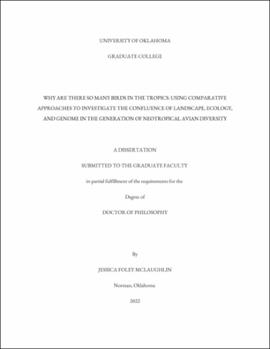| dc.description.abstract | The Neotropics are home to an astonishing level of avian diversity, and thus naturally a focus for the study of the generation of biodiversity. Studies of tropical speciation often focus on large-scale landscape changes, such as the impacts of Pleistocene climate change, the formation of the isthmus of Panama, or the uplift of the Andes. However, the full scope of Neotropical avian diversity is not yet wholly understood, and increasing evidence suggests that other processes beyond these geographical factors contribute to speciation in tropical birds. Here, I examine genetic data, from mitochondrial markers to whole genomes, in a diverse array of Neotropical birds, to better understand the interplay between landscape, genome, and ecology in the development of reproductive isolation. In my first chapter, I use mitochondrial barcodes from over 2,000 birds to detect potential cryptic species across Panama. I find that species-level splits occur in 19% of sampled species, suggesting avian diversity in Panama is substantially underestimated. These disproportionately occurred in species with ecological characteristics associated with low dispersal ability. This is reinforced by the next chapter, in which I use reduced-representation genomic data in ten taxa of lowland Panamanian birds to test whether time is the most important predictor of the outcomes of secondary contact. I find no evidence that time plays a role in determining hybrid zone width in these taxa, and only a partial role in the generation of genomic variation. Instead, diet, which is again linked to dispersal ability as well as demographic changes, is a much better predictor. Finally, I move my focus in Chapter 3 to the Andes, using low-coverage whole genomes to examine the speciation history of the hummingbird genus Aglaeactis. This rapid radiation has significant mitonuclear discord, with completely different phylogenies reconstructed from mitochondrial and nuclear markers. In the two clades defined in the nuclear data, each made of three taxa, I then examined how divergence was distributed across the genome. The three southern taxa, all of which are in allopatry, have overall higher genomic divergence, but it is spread evenly across the genome. In the northern clade, though, I find much lower divergence punctuated by outliers of elevated differentiation. These northern taxa do have contact zones between them, and it is likely that gene flow in that geographic scenario has had a hand in shaping the genomic landscape for the development of reproductive isolation. Taken together, each of these chapters explores how reproductive isolation is the outcome of multiple facets of an organism interacting, and sheds further light on how avian biodiversity is generated. | en_US |

